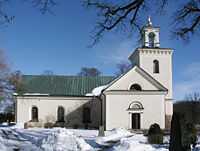Töres döttrar i Wänge

"Töres döttrar i Wänge" ("Töre's daughters in Vänge") or "Per Tyrssons döttrar i Vänge" ("Per Tyrsson's daughters in Vänge") is a medieval Swedish ballad on which Ingmar Bergman's The Virgin Spring is based.[1]
Story
The ballad, which tells the traditional, local legend about why the 12th-century church in Kärna (near Malmslätt in Östergötland, Sweden) was built, was still being sung in the early 19th century, when Erik Gustaf Geijer and Arvid August Afzelius were collecting songs for their three-volume 800 pages work Svenska folk-visor från forntiden ("Ancient Swedish folksongs"), published 1814 and 1816.[2][3][4]
The ballad appears in the third volume, in three versions: the one sung by Greta Naterberg for Afzelius' and Geijer's assistants "J. H." and "D. S. Wallman" in 1812,[5] and two older versions found in manuscript in the Swedish Royal Library; the first accompanied by the note "Pehr Jonson in Frisle sung this song in June 1673".[6] The second is very similar, but has a different refrain and links the song to the nearby church of Kaga instead of Kärna.[7]
The gist of the story is clearer in the 1673 version, which is longer than the one recorded in 1812: The three daughters of Pehr Tyrsson (Töre) and his wife Karin are killed by three highwaymen when on their way to church. Three wells spring up where the three maidens are killed. The men later visit the family farm and try to sell the girls' silk shirts. Karin recognises them and realises that the daughters must have been killed by the men, so she tells her husband. He kills two of them, but lets the third live. When he and Karin ask the surviving highwayman who they are and where they come from, he tells them that they were brothers who had been sent away by their parents when very young, to fend for themselves in the world, and that their parents were Töres and Karin in Vänge. Realising that he has killed his own sons, Töre then vows to build a church to atone for his sins.
According to the notes preceding the ballad, the well of Vänge (Vänge brunn), which appeared at the spot where the young maidens lost their heads, still existed in the 17th century, according to a manuscript from 1673, and an old smithy in the forest nearby was held to be haunted at midnight by the apparitions of the young girls.[8]
A note after the song recorded in 1812 states that the singer, Greta Naterberg, had told the recorders that "vallare" (which usually is understood to mean "herdsmen") here means "robbers" or "highwaymen".[6]
Ballad
The version of the ballad sung by Greta Naterberg in 1812, as recorded by assistants J. H. and/or D. S. Wallman and printed in Svenska folkvisor från forntiden vol. 3 (1816):[8]
|
|
Notes and references
- ↑ Source of Jungfrukällan in the database of the Swedish film institute.
- ↑ Projekt Runeberg: Svenska folk-visor från forntiden - cover page for volume 1 Retrieved 2011-07-17
- ↑ Projekt Runeberg: Svenska folk-visor från forntiden - cover page for volume 2 Retrieved 2011-07-17
- ↑ Projekt Runeberg: Svenska folk-visor från forntiden - cover page for volume 3 Retrieved 2011-07-17
- ↑
- 47E Sveriges Medeltida Ballader, vol. 2. Jonsson et al. ed.Stockholm: Almqvist & Wiksell, 1986, pages 179-180.
- ↑ 6.0 6.1 Google books: Svenska folk-visor från forntiden, tredje delen. Af Erik Gustaf Geijer och Arvid August Afzelius. Stockholm 1816 - page 197 Retrieved 2011-07-17
- ↑ Google books: Svenska folk-visor från forntiden, tredje delen. Af Erik Gustaf Geijer och Arvid August Afzelius. Stockholm 1816 — page 202 Retrieved 2011-07-17
- ↑ 8.0 8.1 Google books: Svenska folk-visor från forntiden, tredje delen. Af Erik Gustaf Geijer och Arvid August Afzelius. Stockholm 1816 - page 193 Retrieved 2011-07-17
- ↑ Translation done by Wikipedia editors.